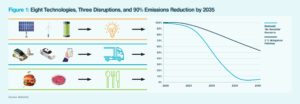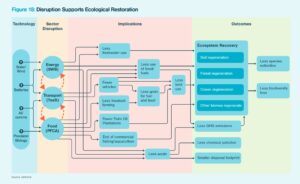According to RethinkX, our society may be heading towards clean disruption. Meaning that in the coming two decades, old and wasteful industries will disappear and new and clean industries will dominate. RethinkX predicts that technology disruptions in just three sectors (energy, transportation, and food & agriculture can eliminate 90% of greenhouse gas emissions worldwide within 15 years. Which will essentially stop climate change. Moreover, this will save trillions of dollars and improve prosperity and quality of life worldwide.

No draconian restrictions
Is this too good to be true? Let’s have a look. RethinkX claims (and documents) that we do not need fusion power or other major unproven breakthroughs. Just disruptions in the three sectors mentioned will do. These disruptions will change older, dirtier industries, just through market forces. In other words, we do not need to rely on draconian governmental restrictions; not on the supply, nor on the demand side of the economy. No austerity policies required!
Moreover, disruptive technologies will continue to become cheaper as their adoption accelerates. At the same time, capabilities improve with scaling. In other words, investment in existing (albeit disruptive) technologies will be the most effective approach. If we focus on existing technologies and scale them up, this will mitigate 90% of emissions. In addition to that, we do have to deploy carbon withdrawal for the remaining 10%; but this will make carbon withdrawal more affordable, for instance through reforestation.
Towards a win-win relationship
Until now, economic growth and human development have come at the cost of the environment. But with the new and disruptive technologies, the relationship between the environment and the economy will change into a win-win relationship, says RethinkX. Moreover, these new technologies will transform geopolitical relations by eliminating geographic advantages and disadvantages. Scarce deposits of fossil fuels will become useless as the world will use much less fossil fuels in twenty years’ time. Disruptive technologies will ever more use local resources.
In their report Rethinking Climate Change (August 2021), the authors argue that disruptions will be more profound and far-reaching, if many economic and social sectors depend on one type of technology. This is the case for central sectors: energy, transportation and food. Any changes in these sectors will have ‘cascading second and third order effects’ in the global economy. For changes in these sectors ‘are not merely a one-to-one replacement of existing technologies, but offer additional capabilities and properties with wholly new uses.’ For instance, the automobile, electricity, internet, personal computers, and smartphones created new markets and served previously unmet (and mainly unknown) needs. This created new systems with emergent properties – consisting both of benefits, and detriments like greenhouse gas emissions.

A cascade of effects
Disruptions will take place simultaneously. Effects will not be simple but ‘complex, unintuitive, and multiplicative’. RethinkX gives the example of road transportation. Here, emissions will be mitigated not just by electrification of vehicles, but also by decarbonization of electricity itself; and by the elimination of ‘a significant fraction of vehicle miles travelled for transportation of livestock, grain, and animal products rendered obsolete by the food disruption’ (p.34).
Such cascading effects will lead to big surprises, RethinkX prophesises. Disruption within one sector will impact cost and capabilities of other technologies. For instance, improvements to batteries will drive the changeover to electric vehicles. And this again will accelerate the disruption of electric power, because car batteries will serve as a storage of excess electricity, to be used when there is little solar and wind power. And disruptions in transportation will again impact ‘geopolitics, greenhouse gas emissions, the layout of cities and participation in the economy’ (p.35).
Major consequences
A sector much impacted will be the steel industry. For as the energy, transportation and food sectors will be disrupted, the demand for steel will be reduced. For instance, approximately 30% of all shipping tonnage in the world consists of oil tankers, and another 40% of ships carry coal, iron ore, cars, trucks, livestock, and grains – all commodities that will be seriously reduced in volume (p.36). This will create a glut of scrap steel. And electric cars contain much less steel than do cars with internal combustion engines. In short, scrapyards will be filled with used steel, aluminium, copper and other materials. We should take into consideration that steel is nearly 100% recyclable. But then, fortunately, solar PV installations and wind turbines will require a lot of steel.
In short, disruptions in the energy, transportation, and food sectors will have major consequences. ‘With just these three disruptions,’ RethinkX writes, ‘we can eliminate 90% of net greenhouse gas (GHG) emissions worldwide by 2035.’ Mainly by one mechanism: just making use of market forces. For ‘the technologies required are either commercially available and competitive today, or can reach the market before 2035 with the right societal choices’ (p.38). Maybe we will still need active reforestation and technology-based carbon withdrawal – but if 90% of the job has been done by market developments, this might be economically affordable for the first time.
Key implications
This brings a number of ‘key implications’. The first of these is that we can achieve net zero emissions much more quickly than is widely imagined, by deploying and scaling the technology we already have got – we already have the technologies we need. And this without collateral damage to society or the economy. Moreover, we don’t need intensive government intervention. Markets can and must play the dominant role in reducing emissions. And decarbonizing the global economy will not be costly, it will instead save trillions of dollars.
A focused approach to reducing emissions is better than an all-of-the-above ‘whack-a-mole’ approach. Let’s concentrate, RethinkX argues, on one single strategy. As a consequence, we no longer need to trade off the environment and the economy against each other. This is no longer a zero-sum game – to the contrary, both sectors will now reinforce each other. The clean disruption of energy, transportation, and food will narrow rather than widen the gap between wealthy and poor communities, and developed and less-developed countries.
The mechanism
The same technologies that allow us to mitigate emissions will also enable us to withdraw carbon dioxide from the atmosphere affordably. Although there is a caveat. Societal choices matter; technology alone is not enough to achieve net zero emissions. Governments should step in; in providing funding for R&D, design efficient markets that will accelerate phase-in of the new technologies, remove market barriers and break up existing monopolies.
Disruptions occur. Think of the creation of the smartphone. Here, 2.5 G technology, touch screens, sensors, processing power and energy-dense lithium-ion batteries converged at just the right time – for the creation of the first smartphone. Often, those in the mainstream fail to see such a disruption coming. New disrupting technologies follow an S-curve. Slow at first, and hardly noticed because at this stage, market penetration is very low (1-2%). But then, the new technology may hit a tipping point. It will suddenly take off and then transform entire markets. Not slowing down in its market penetration until the product nears about 80% of the market. At that point, growth will slow down because the market reaches saturation.
A doable task
In short, the task before us is tremendous, but doable. We should not be shied away from performing this task. As RethinkX tells us: ‘a butterfly is not a faster caterpillar. It is a new system. A new life form. If you think you can add wings to a caterpillar to create a butterfly, you will never understand the new system. A caterpillar needs to go through a phase change transformation to become a butterfly, and when it does, it can fly.’
Interesting? Then also read:
RethinkX: the essentials
A plant-based diet would have a major impact on climate change
RethinkX, an evaluation
